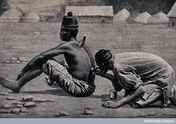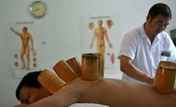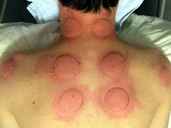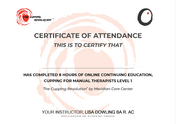Contraindications for Cupping
Contraindications and Cautions
Preamble:
- Overall, cupping is a very safe and easy modality to practice. Cupping therapy is completely unregulated, and therefore it can be performed by anyone. If you practice cupping within a regulated health practice, then you must adhere to the contraindications and legislation indicated within your own scope of practice. If you do not have a college or association, then the best rule of thumb is that if you are not sure, do not proceed until you find a satisfactory response. If you have not had training in a modality, or are not taking extra training to treat certain conditions, then consider it a precaution.
- A detailed health history should be taken from all clients prior to administering cupping therapy.
- A separate consent for is recommended for facial cupping. Extra consent is suggested for cupping, to get into the good habit of asking about any medication, devices, patches, or other contraindication situations may be present. Its important to first be safe, and do no harm in our treatments.
- Always discuss the potential side effects of cupping with your patients. These could include an increase in energy, a lightness of being. These symptoms indicate that the treatment was of an appropriate length and strength. Patients could also feel light headed or dizzy (low blood pressure), have an temporary increase in symptoms (over treated), feel warm, and they can obviously have cupping marks on their body. It is recommended that you discuss the potential and reasons for cupping marks before you start the treatment.
- There are considerations to be addressed for all practitioners. Because we are using a mechanical device, there is a greater capacity to treat with more force. Bearing that in mind, it is important to check in with clients to gauge suction. It should not be painful or uncomfortable. The first time receiving cupping, sometimes clients find the experience of negative pressure massage a bit strange. If there is pain, it is a signal to release some suction on your cups. If the pain does not cease, then you should stop the treatment.
- It is always recommended to start the treatment shorter and lighter, and gradually increase over time. The body does not need to release everything all at once. This could lead to an adverse reaction.
- Another point to address is the circulatory effect of cupping. If a patient has a compromised immune system, or poor circulation, we need to adjust the treatment to ensure we do not over tax it. It is common for clients to feel tired, but usually very relaxed. In some cultures, a warm bath is prescribed after cupping. It is important to make sure clients keep their body covered and warm, especially in the winter months.
- Finally, hydration is another consideration with cupping. With very dry skin, you may find the cups do not attach easily. Hydration is an important part of good health, and can lead to a host of health issues.
- When you are removing the cups, make sure to release the vacuum away from your self, and your patient. If anything has been captured by the cup, it should be released into the air, rather than onto the practitioner. Cupping should be performed in a wellventilated area.
- Use proper disinfection techniques. (see section on cleaning and disinfection below) ✓ Understand your responsibility for proper cleaning of cups, especially when working on the public.
- Use suitable cups for the area being treated. Using an appropriate sized cup will make the treatment more effective. ✓ Small cups are for local treatment, deep conditions, and small body areas. ✓ Large cups are for more superficial conditions, large body areas, and for more diffuse suction.
Precautions
Always take sensible precautions when using cupping.
- Cupping is not effective on areas where there is excessive body hair, or irregular angles. ✓ If a client has body hair, practitioners can shave the area, or apply some massage lotion or oil to attempt to create contact with the skin.
- Avoid performing cupping on areas that have had a spray tan. The risk of infection can be increased, and the effect is unsavory.
- Take extra care with children and the elderly, those with weaker constitutions, chronic illnesses, and immune system or circulatory problems. ✓ They should be treated with a shorter duration (maximum total 5 minutes) and lighter suction. ✓ Light to light-medium suction should be used.
- Do not apply strong cupping to the face. ✓ Use the most superficial suction for gliding ✓ Use lighter than medium suction for stationary cupping over the TMJ area if you have consent. ✓ Cupping is contraindicated on the face at the site of Botox injections The tissue on the face is delicate and can be easily damaged. It also marks very easily.
- Cupping should only be done on the soft muscle tissue and caution should be taken where the muscle layer is thin or is not level because of bony projections or angles.
Contraindications
The contraindications for cupping include, and are not necessarily limited to
- high fever, convulsions or cramps
- Do not cup a client if they have a sunburn. This can tear and further damage the skin.
- allergic skin conditions, or ulcerated sores. ✓ If a skin ulceration occurs, the cup being used must be sterilized using an autoclave, treated with high-level disinfectant, or disposed of safely using a biohazard waste container (found at most pharmacies and medical offices)
- Do not treat the affect limb on a client with lymphedema
- Lymphatic Blood Cancers
- Do not treat the abdomen or lower back of pregnant women. ✓ Some sources to not treat the abdomen or lower back after 16 weeks, but I advise to avoid these areas throughout pregnancy to be safe. ✓ The limbs, upper back and ribs, gluteal muscles are all fine to treat during pregnancy.
- Do not use cupping on inflamed or cut skin, or over existing cupping marks. The vessels need to heal completely before being retreated. ✓ If the skin becomes irritated during treatment, and the red petechiae marks appear, discontinue the treatment. ✓ If there has been a cut or perforation in the skin, do not use cupping on the local site. ✓ Avoid cupping over recent injections sites. This includes insulin injections, steroid treatment, pain patches or other injections ✓ 72 hours should be in between injections and local cupping treatment< • Take Extra Care when scraping the skin and do not cut a vein or artery. ✓ If a break in the skin occurs, and the cupping vessel has made contact with the broken skin, sterilization or disposal of the cup is necessary.
- Do not treat people with a serious heart disease, or any serious or chronic health conditions, unless you have training in that condition. Always stay with in your depth of knowledge. • Do not perform cupping directly over a disc herneation.
- Avoid treating patients who have a history of DVT (Deep Vein Thrombosis, AKA Blood clot) or any clotting disorder. ✓ Check for blood thinners and other medications before performing cupping
